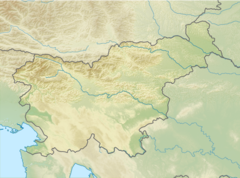Potok Cave
Potočka zijalka | |
 Entrance to Potok Cave | |
| Location | above Solčava |
|---|---|
| Region | eastern Karawanks Slovenia |
| Coordinates | 46°26′56″N 14°40′07″E / 46.44889°N 14.66861°E |
| Type | limestone karst |
| Length | 115 m (377 ft) |
| Width | 40 m (130 ft) |
| History | |
| Material | Triassic limestone |
| Periods | Upper Paleolithic |
| Associated with | Paleo-humans |
Potok Cave
Location
The cave is located in the eastern Karawanks in northern Slovenia, on the southern slope of Mount Olševa above Solčava, at an elevation of 1,675 m (5,495 ft) in the Triassic limestone.[8] It is 115 m (377 ft)[9] long and varies from 17 m (56 ft) wide at the mouth to 40 m (130 ft) wide in the interior.[9] Its entry opens toward the south.[8]
Role
There are two explanations of its role. According to the original explanation, the cave was a hunting station. According to the newer one, it was a ritual place.[8]
Excavations
After amateur excavations by Josef Gross, a medical student from Austria, the area was bought by the Museum Society of Celje. Systematic excavations were carried out on its behalf by archaeologist Srečko Brodar, starting in 1928[10] and continuing until 1935.[9]
The finds from eight layers excavated from the cave included the bones of more than 40 animal species, including
Exhibits
In a village near the cave, a permanent exhibit is open for tourists at the Firšt Inn and Museum in the Logar Valley.[12] The other finds can be seen at the Celje Regional Museum. Unfortunately much of the collection was destroyed during World War II in 1945 Allied bombing raids.[9]
Gallery
-
Inside Potok Cave
-
Inside Potok Cave
See also
References
- ^ Snodgrass, Mary Ellen. 2014. World Clothing and Fashion: An Encyclopedia of History, Culture, and Social Influence. New York: Routledge, p. 207.
- ^ Dowson, Thomas. 2013. "Views from Ancient Doorways," Archaeology Travel.
- ^ Bezlaj, France. 1961. Slovenska vodna imena, vol. 2. Ljubljana: SAZU, p. 337.
- ^ "Potočka zijavka". Parc.si. Palaeolithic Research Centre. Archived from the original on 2012-10-03.
- ^ Mišič, Franc. 1938. "O ledinskih in hišnih imenih okoli Solčave." Časopis za zgodovino in narodopisje 33(3/4): 191–201, p. 195.
- ^ a b SlovLit: Potočka zijalka (in Slovene)
- ^ Bezlaj, France et al. 2005. Etimološki slovar slovenskega jezika vol. 4. Ljubljana: SAZU, p. 411.
- ^ a b c d e Debeljak, Irena; Turk, Matija. "Potočka zijalka". In Šmid Hribar, Mateja; Torkar, Gregor; Golež, Mateja; et al. (eds.). Enciklopedija naravne in kulturne dediščine na Slovenskem – DEDI (in Slovenian). Archived from the original on 15 May 2012. Retrieved 12 March 2012.
- ^ a b c d Broda, Mitja. 1995. "Potočka zijalka." Enciklopedija Slovenije, vol. 9, Ljubljana: Mladinska knjiga, pp. 193–194.
- ^ Brodar, Srečko, & Mitja Brodar. 1983. Potočka zijalka, visokoalpska postaja aurignacienskih lovcev. Ljubljana: SAZU, p. 12.
- ^ Odar, Boštjan (2008). "A Dufour Bladelet from Potočka zijalka (Slovenia)" (PDF). Arheološki vestnik. 59: 13.
- ^ Stalna razstava Potočka zijalka (Potok Cave Permanent Exhibit) (in Slovene)
External links
 Media related to Potok Cave at Wikimedia Commons
Media related to Potok Cave at Wikimedia Commons





